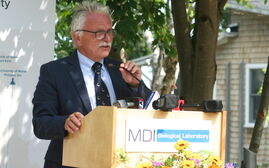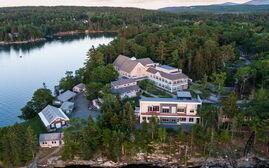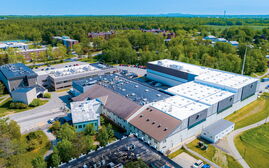Processing Your Payment
Please do not leave this page until complete. This can take a few moments.
- News
-
Editions
View Digital Editions
Biweekly Issues
- Nov. 17, 2025
- November 03, 2025
- October 20, 2025
- October 6, 2025
- September 22, 2025
- September 8, 2025
- + More
Special Editions
- Lists
- Viewpoints
-
Our Events
Event Info
Award Honorees
- Calendar
- Biz Marketplace
Where will Maine's STEM students go to work?
 Photo / Courtesy MDI Biological Laboratory
Isaiah Mansour, a University of Maine, Orono, senior, studying the roundworm C. elegans in 2016 as an MDI Biological Laboratory summer fellow.
Photo / Courtesy MDI Biological Laboratory
Isaiah Mansour, a University of Maine, Orono, senior, studying the roundworm C. elegans in 2016 as an MDI Biological Laboratory summer fellow.
Amid the recent buzz of entrepreneurs at Maine Startup and Create Week, I talked to Kevin Strange, president of the MDI Biological Laboratory in Bar Harbor, about his take on entrepreneurship and STEM education in the state.
Strange quickly focused on the incubator of five startup companies MDIBL has attracted to the campus, and how those entrepreneurs might cross-pollinate information with scientists at the lab and elsewhere to piqued their interest in starting companies or commercializing their research. He also talked about programs to give high school and college students hands-on experience at the lab so they can see if science is a career for them.
His approach is to get at students early. There are various internships to get students on campus, but he also wants to leverage INBRE, the IDeA Network of Biomedical Research Excellence, which is a collaborative network of more than a dozen Maine educational and research institutions sponsored by the National Institutes of Health. INBRE aims to create a technically skilled workforce, and Strange wants to assure that includes interacting with businesses that eventually could hire the students.
Maine is better at attracting students to STEM disciplines, but “the problem is work and opportunity for them to keep them in the state,” he said. Strange pointed to University of Maine, Orono, senior Isaiah Mansour, a double major in marine biology and aquaculture, as an example of a student who he'd like to nurture at the lab, and potentially see start a company.
Mansour is now working with Rebecca Morrison, the laboratory manager of the Strange research lab, to oversee his work in adjuvants, which are agents added to a vaccine to help it amplify the body's immune response.
Mansour said one California company has developed an adjuvant using a sea snail, but it is high priced because the sea snail it uses is in short supply. He is looking for an alternative using a more broadly available sea snail, red abalone. That snail is in the wild and has been grown in an aquaculture setting at the University of Maine.
While the red abalone blood can potentially be used for the new adjuvant, the entire snail also can be used. “The meat is a delicacy and the shell can be used for mother-of-pearl jewelry,” he said.
Mansour already has isolated the potential adjuvant, and is working on the next step, purifying and analyzing its two components, at MDIBL.
If successful with the red abalone adjuvant, Mansour said he'd like to stay in research, but with business courses under his belt, he'd like to start a company and potentially join MDIBL's existing incubator.
When Mansour talks to his peers, the issue isn't a matter of interest in STEM subjects, but what happens later.
“There are tons of STEM students in Maine,” the Connecticut native said. “We need to foster a job market to keep the students in Maine. Labs and companies should work together.”
He added, “Every science student in Maine helps create a community that could help develop the fledgling entrepreneurial network.”
Mainebiz web partners
Related Content

The Giving Guide
The Giving Guide helps nonprofits have the opportunity to showcase and differentiate their organizations so that businesses better understand how they can contribute to a nonprofit’s mission and work.
Learn More
Work for ME
Work for ME is a workforce development tool to help Maine’s employers target Maine’s emerging workforce. Work for ME highlights each industry, its impact on Maine’s economy, the jobs available to entry-level workers, the training and education needed to get a career started.
Learn More
Groundbreaking Maine
Whether you’re a developer, financer, architect, or industry enthusiast, Groundbreaking Maine is crafted to be your go-to source for valuable insights in Maine’s real estate and construction community.
Learn more-
The Giving Guide
The Giving Guide helps nonprofits have the opportunity to showcase and differentiate their organizations so that businesses better understand how they can contribute to a nonprofit’s mission and work.
-
Work for ME
Work for ME is a workforce development tool to help Maine’s employers target Maine’s emerging workforce. Work for ME highlights each industry, its impact on Maine’s economy, the jobs available to entry-level workers, the training and education needed to get a career started.
-
Groundbreaking Maine
Whether you’re a developer, financer, architect, or industry enthusiast, Groundbreaking Maine is crafted to be your go-to source for valuable insights in Maine’s real estate and construction community.
ABOUT
NEW ENGLAND BUSINESS MEDIA SITES
No articles left
Get access now
In order to use this feature, we need some information from you. You can also login or register for a free account.
By clicking submit you are agreeing to our cookie usage and Privacy Policy
Already have an account? Login
Already have an account? Login
Want to create an account? Register
Get access now
In order to use this feature, we need some information from you. You can also login or register for a free account.
By clicking submit you are agreeing to our cookie usage and Privacy Policy
Already have an account? Login
Already have an account? Login
Want to create an account? Register










Comments